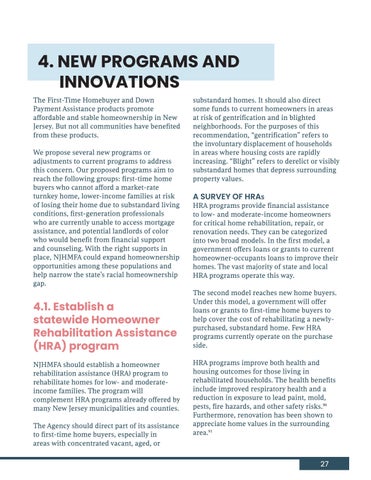4. NEW PROGRAMS AND INNOVATIONS
The First-Time Homebuyer and Down Payment Assistance products promote affordable and stable homeownership in New Jersey. But not all communities have benefited from these products. We propose several new programs or adjustments to current programs to address this concern. Our proposed programs aim to reach the following groups: first-time home buyers who cannot afford a market-rate turnkey home, lower-income families at risk of losing their home due to substandard living conditions, first-generation professionals who are currently unable to access mortgage assistance, and potential landlords of color who would benefit from financial support and counseling. With the right supports in place, NJHMFA could expand homeownership opportunities among these populations and help narrow the state’s racial homeownership gap.
4.1. Establish a statewide Homeowner Rehabilitation Assistance (HRA) program NJHMFA should establish a homeowner rehabilitation assistance (HRA) program to rehabilitate homes for low- and moderateincome families. The program will complement HRA programs already offered by many New Jersey municipalities and counties. The Agency should direct part of its assistance to first-time home buyers, especially in areas with concentrated vacant, aged, or
substandard homes. It should also direct some funds to current homeowners in areas at risk of gentrification and in blighted neighborhoods. For the purposes of this recommendation, “gentrification” refers to the involuntary displacement of households in areas where housing costs are rapidly increasing. “Blight” refers to derelict or visibly substandard homes that depress surrounding property values.
A SURVEY OF HRAs
HRA programs provide financial assistance to low- and moderate-income homeowners for critical home rehabilitation, repair, or renovation needs. They can be categorized into two broad models. In the first model, a government offers loans or grants to current homeowner-occupants loans to improve their homes. The vast majority of state and local HRA programs operate this way. The second model reaches new home buyers. Under this model, a government will offer loans or grants to first-time home buyers to help cover the cost of rehabilitating a newlypurchased, substandard home. Few HRA programs currently operate on the purchase side. HRA programs improve both health and housing outcomes for those living in rehabilitated households. The health benefits include improved respiratory health and a reduction in exposure to lead paint, mold, pests, fire hazards, and other safety risks.90 Furthermore, renovation has been shown to appreciate home values in the surrounding area.91
27







